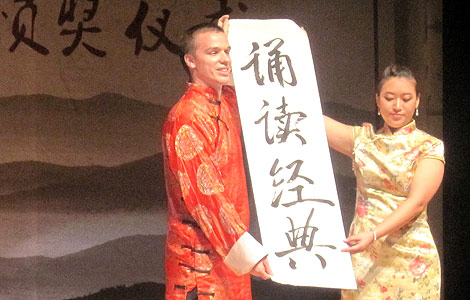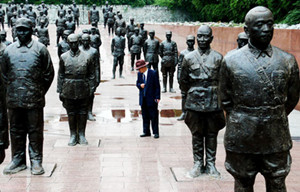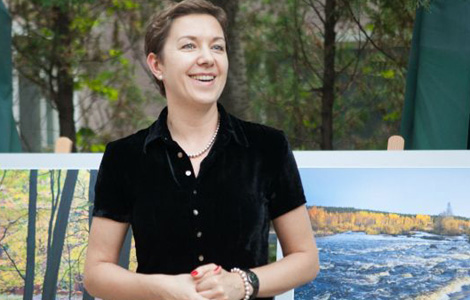
 'Taken 2' grabs movie box office crown
'Taken 2' grabs movie box office crown
 Rihanna's 'Diamonds' tops UK pop chart
Rihanna's 'Diamonds' tops UK pop chart
 Fans get look at vintage Rolling Stones
Fans get look at vintage Rolling Stones
 Celebrities attend Power of Women event
Celebrities attend Power of Women event
 Ang Lee breaks 'every rule' to make unlikely new Life of Pi film
Ang Lee breaks 'every rule' to make unlikely new Life of Pi film
 Rihanna almost thrown out of nightclub
Rihanna almost thrown out of nightclub
 'Dark Knight' wins weekend box office
'Dark Knight' wins weekend box office
 'Total Recall' stars gather in Beverly Hills
'Total Recall' stars gather in Beverly Hills
Sunflower weighed down with history
Updated: 2013-05-20 15:20
By Deng Zhangyu (China Daily)
|
||||||||
 |
|
A sculpture featuring 600 sunflowers by chinese artist Xu Jiang is showcased in Koblenz,Germany. Photo provided to China Daily |
At the confluence where the Rhine joins the Moselle in Germany's Koblenz is an unusual sight - a sunflower garden of copper. It is a collection of sunflower sculptures, each 6 to 8 meters tall.
It's the first time the German Corner, a landmark of Koblenz, has hosted an art exhibition and Chinese artist Xu Jiang has brought his show Re-Generation to the city, rebuilt from ruins after World War II.
"It's an ideal place to present my show. Both of them are coated with historical dust," says Xu, president of China Academy of Art.
Xu's sunflowers have traveled to Dresden, another city rebuilt after World War II, and have stood in the snow in Kassel.
Xu says he wants to speak to the generation who grew up in Germany after the war, which is why he chose Dresden, Kassel and Koblenz for his exhibitions.
"My generation has experienced China's great changes: the 'cultural revolution' (1966-76), working in the countryside and reform and opening up. Our youth were once distorted, but we still grow with our country," says the 58-year-old.
Xu was born in 1955 in Fujian province. He worked in a factory at age 20 and later became a college student. He studied in Germany and returned to China to be an art professor.
His exhibition comprises works on canvas, paper and sculpture installations. All revolve around a single subject - sunflowers in a field.
Since 2003, Xu has focused on sunflowers which represent the collective memory of his generation. It was common to see them in Chinese drawings from the 1950s to 1970s.
Unlike Van Gogh's sunflowers, vibrant and flamboyant, Xu's sunflowers are wilted and crowded in large groups.
"My generation share a lot of memories. We sing the same songs, wear the same clothes and have the same experiences. They are the sunflowers I made."
Although his sunflowers are standing in the sunset, they once stood toward the sunrise, says Xu. "We're not young. But we once had our dreams. There is a kind of bitterness about my sunflowers, but not anguish," says the artist.
A decade ago, Xu visited a mansion in Austria. A sea of sunflowers on the mountain blossomed under the sunshine, vibrant and glowing. But he was not moved.
Only when he went to Marmara in Turkey was he touched by a withered sunflower garden. Their leaves curled and drooped, they stood tall and strong against the sunset.
"They looked like old soldiers waiting for their last review. They reminded me of our fate," recalls Xu.
Xu says sunflowers have two sides: fervent and tough. He prefers the latter.
For his one-year retrospective exhibition in Germany, Xu spent half a year creating the 600 sunflower sculptures, and he included another 200 lotus blooms.
Xu says he tries to explore the topic of possibility of symbiosis - putting sunflowers living in soil and lotus in water together.
"It's like the art of West and East. We can communicate with each other through the language of arts," he says.
A group of German children visited the German Corner where Xu's show was located. They were excited and each of them drew a picture of sunflowers. Their teacher helped them turn their pictures into paper flowers and stuck them on a box, and a paper sunflower garden took shape.
"So exciting! That's what I want - to talk to them through art," says Xu. The exhibition runs until June 18.
|
|
|
Most Viewed
Editor's Picks

|

|

|

|

|

|
Today's Top News
Shenzhou X astronaut gives lecture today
US told to reassess duties on Chinese paper
Chinese seek greater share of satellite market
Russia rejects Obama's nuke cut proposal
US immigration bill sees Senate breakthrough
Brazilian cities revoke fare hikes
Moody's warns on China's local govt debt
Air quality in major cities drops in May
US Weekly

|

|









